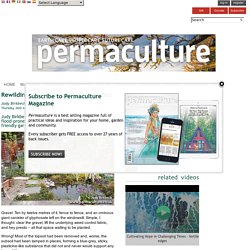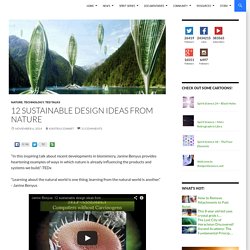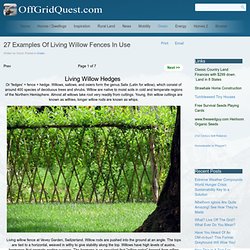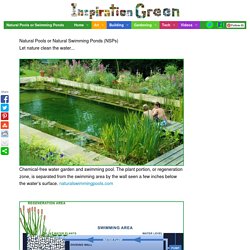

Rewilding and Restoring A Small Garden. Gravel.

Ten by twelve metres of it, fence to fence, and an ominous giant canister of glyphosate left on the windowsill. Simple, I thought: clear the gravel, lift the underlying weed control fabric, and hey presto – all that space waiting to be planted. Wrong! Most of the topsoil had been removed and, worse, the subsoil had been tamped in places, forming a blue-grey, sticky, plasticine-like substance that did not and never would support any form of life. How Physics Gives Structure to Nature. How do bees do it?

The honeycombs in which they store their amber nectar are marvels of precision engineering, an array of prism-shaped cells with a perfectly hexagonal cross-section. The wax walls are made with a very precise thickness, the cells are gently tilted from the horizontal to prevent the viscous honey from running out, and the entire comb is aligned with the Earth’s magnetic field. Yet this structure is made without any blueprint or foresight, by many bees working simultaneously and somehow coordinating their efforts to avoid mismatched cells.
Resonance Science Foundation - Posts. April 2011. Probably the most important aspect of water -- the thing that causes most of it's unique properties -- is its electric polarity.

When an Oxygen atom bonds with two Hydrogen atoms to form water, the Hydrogens always bond to the Oxygen atom at one end. This makes the hydrogen side of the molecule electro-positive, and the other side, with free electrons, electro-negative. The opposite charges of the two sides makes water molecules strongly attracted to each other -- and to many other electrically "polar" molecules, which makes water such a good solvent. This electric attraction is the reason for water's exceptionally strong surface tension. Which makes water droplets form such perfect spheres, that billions of these droplets reflect and refract sunlight so consistently that we see the whole visible spectrum of light displayed in rainbows all the time. (3) James Furia - Musical Geometry.
James Furia - Musical Geometry. Ellen MacArthur Foundation. In a circular economy, economic activity builds and rebuilds overall system health.

The concept recognises the importance of the economy needing to work effectively at all scales – for large and small businesses, for organisations and individuals, globally and locally. Transitioning to a circular economy does not only amount to adjustments aimed at reducing the negative impacts of the linear economy. Rather, it represents a systemic shift that builds long-term resilience, generates business and economic opportunities, and provides environmental and societal benefits. Technical and biological cycles The model distinguishes between technical and biological cycles.
Origins of the circular economy concept The notion of circularity has deep historical and philosophical origins. Circular economy schools of thought The circular economy model synthesises several major schools of thought. Michael Pawlyn: Using nature's genius in architecture.
Biomimicry furniture. Could Mushrooms Be The Savior To The World’s Radiation & Petroleum Footprint? Listen To This Remarkable Lecture. 12 Sustainable Design Ideas from Nature. “In this inspiring talk about recent developments in biomimicry, Janine Benyus provides heartening examples of ways in which nature is already influencing the products and systems we build.”

-TEDx. 27 Examples Of Living Willow Fences In Use. Living Willow Hedges Or 'fedges' = fence + hedge.

Willows, sallows, and osiers form the genus Salix (Latin for willow), which consist of around 400 species of deciduous trees and shrubs. Willow are native to moist soils in cold and temperate regions of the Northern Hemisphere. Almost all willows take root very readily from cuttings. Young, thin willow cuttings are known as withies, longer willow rods are known as whips.
Tree tunnel. Natural architecture - an emerging art movement that is exploring mankind's desire to reconnect to the earth, through the built environment. Natural Swimming Ponds. Natural swimming ponds, also called natural pools, are a wonderful way to recreate nature in your backyard.

They offer a much lower maintenance alternative to conventional pools and allow you to swim in clean, chemical free water. Consider this comment from member, Emma O’Connor (left on our Natural Ponds blog): “I would love one of these. As a swimming teacher by trade I spend much time in chlorinated water…. not fun for skin, hair or eyes.” Another pool converted to a swimming pond Wetlands have been purifying water for hundreds of millions of years so it should not surprise anyone that you can do the same in your backyard. Click on any image to start lightbox display. Natural Pools - Natural Pool selfbuild.
Natural Pools or Swimming Ponds. Natural Pools or Natural Swimming Ponds (NSPs) Let nature clean the water...

Chemical-free water garden and swimming pool. The plant portion, or regeneration zone, is separated from the swimming area by the wall seen a few inches below the water’s surface. naturalswimmingpools.com The pools have skimmers and pumps that circulate the water through the regeneration zone and back into the swimming area.
The aquatic plants filter out contaminants and use nutrients from the water as food which helps prevent algae. Then rocks, such as granite river rock or haydite, to which friendly bacteria attach, act as biological filters. Natural pools are beautiful and environmentally friendly. A natural swimming pool is a magical addition to a home where you can observe nature throughout the seasons and be closer to the wildlife you share your land with.

Some of the creatures you will attract are insects like water beetles and dragonflies; birds will visit the pond to bathe, feed and collect nesting material and amphibians like the frog and newt will take up residence. Your pond will become a stepping stone for the wilderness where local native flora and fauna will find your pool and flourish. A conventional sterile pool will typically cost around £50,000 ($80,000) but a 180 m2 (2,000 ft2) organic pool like the one above only cost David about £6,000 ($10,000) to make. Facebook. Facebook. Terra Preta Toilets.
Urine diversion terra preta toilets are dry terra preta sanitation (TPS) systems based on urine diversion, lacto-fermentation, the addition of charcoal and vermicomposting to produce lasting and highly fertile soils with properties similar to the terra preta soils (GENSCH 2010 b).

Pre-Columbian native populations generated terra preta soils, literally “black earth”, by incorporating large amounts of charred residues (charcoal) either produced intentionally or as a by-product from human activity into the soil together with nutrient-rich material (GLASER 2006). Nutrient-rich material was used to be human and animal manure (rich in P and N), waste including mammal and fish bones (rich in P and Ca), ash residues of incomplete combustions (rich in Ca, Mg, K, P and charcoal) or plant biomass (e.g. kitchen wastes, compost, algae etc.)
(GLASER 2006). A typical soil from the Amazonian region (left). 8 Toilet Designs That Could Save Millions of Lives Around the World Sabine Schober Toilet - Gallery Page 4. Open Source Ecology. Natural Swimming Pools - a guide to designing & making your own. GeoPathfinder. GeoPathfinder.com has moved to new addresses! The information on this page is no longer being updated or maintained. It has been divided into new categories, and it is built and edited using new software. The new categories and pages, formerly known as our Food Preservation Page are:Solar Food Drying , Energy-Wise Cooking & Canning , The Four-Season Pantry , and Live Food Storage . The following information is still posted for historical purposes only. Energy Efficient Food Preservation.
Design in/ with Nature. The Willow Man and cradle to cradle living. Natural Pools - Natural Swimming Pools and Ponds. DIY Rustic Wood Table. Natural Pools or Swimming Ponds. A chandelier that turns a room into a forest.
Edible & Ecological Landscapes.